| Location | Corfinio |
|---|---|
| Type | Archaeology museum |
| Website | http://www.museocorfinio.it/ |
Museo civico archeologico Antonio De Nino (Italian for Antonio De Nino Archaeology Civic Museum) is an archaeology museum in Corfinio, Abruzzo. [1]
| Location | Corfinio |
|---|---|
| Type | Archaeology museum |
| Website | http://www.museocorfinio.it/ |
Museo civico archeologico Antonio De Nino (Italian for Antonio De Nino Archaeology Civic Museum) is an archaeology museum in Corfinio, Abruzzo. [1]
The museum was opened in 2005, housed in the Colella-Trippitelli family palace, dating back to the 17th century, to host the artifacts discovered during the excavations carried out by Antonio De Nino in Corfinio at the end of the 19th century and continued by Don Nicola Colella, canon of San Pelino.
The artifacts recovered during the 1878 excavations were initially housed in the rooms of the Oratory of Sant'Alessandro, but the museum was plundered during the German occupation in World War II. The exhibition was temporarily reassembled in rooms adjacent to the cathedral but the collection was eventually transferred to Chieti until the opening of the new museum.
The museum's ten rooms are spread over two floors. On the ground floor, there is a reconstruction of Antonio De Nino's study, with some of his works and some of the artifacts he found. The first floor houses the exhibition rooms organized by thematic areas.

The National Archaeological Museum of Naples is an important Italian archaeological museum, particularly for ancient Roman remains. Its collection includes works from Greek, Roman and Renaissance times, and especially Roman artifacts from the nearby Pompeii, Stabiae and Herculaneum sites. From 1816 to 1861, it was known as Real Museo Borbonico.
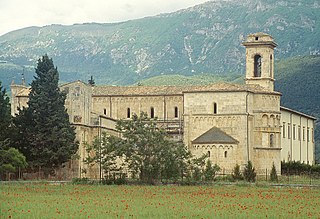
Corfinio is a comune (municipality) and town in the province of L'Aquila, in the Italian region of Abruzzo.

The Museo Correr is a museum in Venice, northern Italy. Located in St. Mark's Square, Venice, it is one of the 11 civic museums run by the Fondazione Musei Civici di Venezia. The museum extends along the southside of the square on the upper floors of the Procuratorie Nuove. With its rich and varied collections, the Museo Correr covers both the art and history of Venice.

The Museo Civico d'Arte Antica is an art museum located in the Palazzo Madama in Turin, Italy. It has a renowned collection of paintings from the medieval, Renaissance and Baroque periods. It reopened in 2006 after several years of restorations.

The Museo Nazionale della Magna Grecia, Museo Archeologico Nazionale di Reggio Calabria or Palazzo Piacentini is a museum in Reggio Calabria, southern Italy, housing an archaeological collection from sites in Magna Graecia.

The Archaeological Museum of Populonia, opened in 2001 in the town of Piombino, Italy, contains artifacts from what was the ancient territory of Populonia during a period ranging from prehistory to late antiquity. The museum contains an active center of experimental archaeology with a focus on the processing of ceramics and stone.
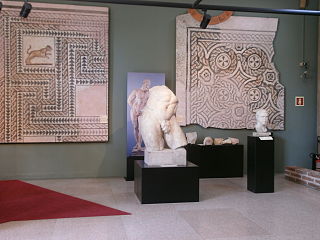
The Archaeological Museum of Milan is located in the ex-convent of the Monastero Maggiore, alongside the ancient church of San Maurizio al Monastero Maggiore, with entrance on Corso Magenta.

The Antonino Salinas Regional Archeological Museum is a museum in Palermo, Italy. It possesses one of the richest collections of Punic and Ancient Greek art in Italy, as well as many items related to the history of Sicily. Formerly the property of the Oratory of Saint Philip Neri, the museum is named after Antonino Salinas, a famous archaeologist and numismatist from Palermo who had served as its director from 1873 until his death in 1914, upon which he left it his major private collection. It is part of the Olivella monumental complex, which includes the Church of Sant'Ignazio all'Olivella and the adjoining Oratory.
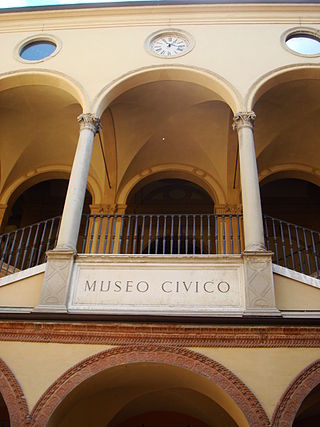
The Archaeological Civic Museum of Bologna is located in the fifteenth-century Palazzo Galvani building at Via dell'Archiginnasio 2 postal code 40124 Bologna, once known as the Hospital of Death. Founded in September 1881 by the merging of two separate museums: the one belonging to the University of Bologna – heir of the Room of Antiquity belonging to the Academy of Sciences founded by Luigi Ferdinando Marsili in (1714) – and that belonging to the City of Bologna (enriched by the antique collection of Artist Pelagio Palagi and the large amount of finds from excavations conducted in and around Bologna during these times.

The Archaeological Museum of Savona is located in Palazzo della Loggia inside the Priamar Fortress. It presents the history of the Priamar promontory and the town of Savona. On the exposition are old collections of objects from around the Mediterranean and artifacts from the 20th century excavations of the fortress and its surrounding. The museum has two floors and inside it is possible to see original excavation pits.

The Museo Archeologico Regionale Paolo Orsi of Syracuse, Sicily is one of the principal archaeological museums of Europe.

The Castello di Masnago is a castle, now a civic art museum, located atop a hill on Via Cola di Rienzo number 42 in Mantegazza Park in the quartiere of Masnago of the town of Varese, region of Lombardy, Italy. The oldest part of the castle is an 11th-century crenellated tower, much rebuilt over the centuries. On the ground floor, there is a frescoed room, the Sala degli Svaghi, and in the first floor two exhibition rooms – Sala dei Vizi and delle Virtù. Some of the latter frescoes pertain to the 15th-century school of Bonifacio Bembo.
Museo Civico may refer to:

Museo archeologico Francesco Savini is an archaeology museum in Teramo, Abruzzo.
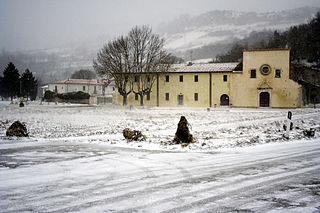
Museo civico aufidenate is an archaeology museum in Castel di Sangro, Province of L'Aquila (Abruzzo).
Museo Archeologico Nazionale di Campli is an archaeology museum in Campli, Abruzzo.

Museo civico aufidenate Antonio De Nino is an archaeology museum in Alfedena, Abruzzo.
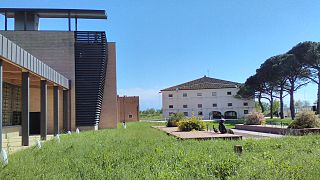
The National Archaeological Museum of Altino is an archaeology museum next to the archaeological site of Altinum. It is located in the frazione Altino of the municipality of Quarto d'Altino, in the Metropolitan City of Venice.

The Turin Civic Gallery of Modern and Contemporary Art is an art gallery in Turin, Italy, founded in 1891-1895 and located in 31 via Magenta. With the MAO, Palazzo Madama e Casaforte degli Acaja, the Borgo and the Rocca medioevali, it forms part of the Fondazione Torino Musei. The lower rooms house important reviews and a large collection of video art.